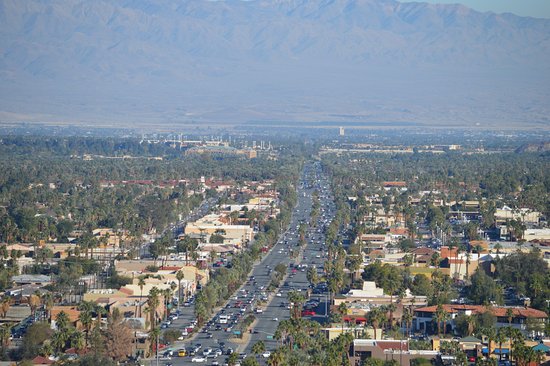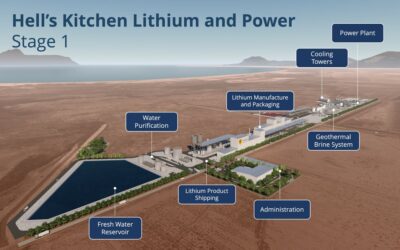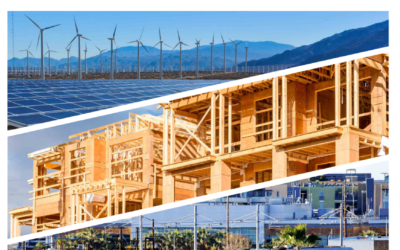At the 2021 Coachella Valley Virtual Business Conference and Economic Forecast, held on April 29, County of Riverside leaders provided an update on their efforts to help spur economic recovery, announced a change in their department leading economic development efforts and hosted a comprehensive keynote presentation by Dr. Christopher Thornberg, the director of the UC Riverside School of Business Center for Economic Forecasting and Development.
Recently appointed Riverside County Executive Officer, Jefferey Van Wagenen, who leads the day-to-day operation of 40 departments with more than 22,000 employees and a $6 billion annual budget, set the stage for the conference by underscoring the County’s firm commitment to economic recovery and growth.
“Economic development has been and continues to be a top priority of the County of Riverside,” said Van Wagenen. “We are now on the precipice of a massive infrastructure bill working its way through the federal government and funding from the American Rescue Plan Act which is the next evolution of COVID relief and recovery funding. Almost $500 million will be coming to Riverside County government, and our cities will be getting their own separate allocation of relief funding which means millions of dollars flowing to businesses. The time for investment is now to yield results for years to come.”
With an eye on fiscal responsibility, Van Wagenen noted, “Supervisor (V. Manuel) Perez, along with our Board of Supervisors, is focused on making sure we are using those dollars in the most efficient way and that we are helping the industries that have been the most impacted during the last year.”
Van Wagenen shared his reasons for optimism as we all look for light at the end of the proverbial tunnel, “Although the data shows that we are not back to normal yet, I am optimistic for several reasons. I am optimistic because the COVID case numbers continue to fall. I feel optimistic as the vaccination numbers continue to rise. As we begin to see life and commerce return to normal, I am optimistic and I’m not the only one feeling this way. As I meet with people representing a wide range of private, public and nonprofit organizations across the County I see that this feeling of optimism is spreading. It’s palpable and it’s real.”
Supervisor Manuel Perez, who has been an absolute dynamo and staunch small business advocate during these challenging times, announced a change in the name of the County’s department overseeing economic development. The former Riverside County Office of Business and Community Services Department is now known as the Riverside County Office of Economic Development at Perez’ request. The director of the department is Suzanne Holland who led the conference as master of ceremonies.
“Especially since March 2020, it has been a rollercoaster ride, but support of small businesses has been a high priority and one of our key focuses,” said Supervisor Perez. “We always strive to be business friendly. After a year of unprecedented difficulties, we are finally seeing signs of a turning point and achieving important milestones.”
Supervisor Perez noted the considerable strides the County has made in reducing COVID through aggressive vaccination procurement, outreach and impressive operations. “My message is vaccinate, don’t procrastinate,” he said.
Pointing to some of the ways the County jumped in to help support the regional economy, Perez noted, “Along the course of this year, we formed the Riverside County Economic Recovery Task Force, which has helped support businesses and reopening the economy. One of the programs that emerged was the Riverside County Small Business Assistance Program utilizing federal stimulus funding the county received. It provided grants of up to $10,000 to companies in the county that concluded last December. It was $15 million that supported 5,000 small businesses countywide. Of the total, $10 million came to companies in the 4th District. We were able to financially assist 1,029 companies that supported an estimated 3,122 jobs.”
In a precursor to the keynote presentation, Supervisor Perez pointed to the importance of upgrading infrastructure throughout the region. “The key to being able to move forward is infrastructure. It’s how we can have more affordable housing, clean drinking water, improved sanitation systems, better parks and recreation and what everyone is talking about – broadband internet capacity and access. As you hear about proposals in infrastructure going forward, know that it is a critical driver of our economy. We strongly champion and advocate for improved infrastructure.”
Four Big Themes
Economist Dr. Christopher Thornberg set up his presentation by identifying four “big themes.”
His first theme is that we must recognize that the pandemic was a human tragedy that can be likened to a global natural disaster which has a completely different kind of effect on economies than the more traditional sources of negative business cycles. “It was always the case that we were going to come out of the pandemic with a V-shaped recovery because that’s how regions have always reacted to natural disasters,” Dr. Thornberg noted.
The second big theme is based on the government reaction to the pandemic which was characterized by an overwhelming combination of fiscal and monetary policy moves even though the V-shaped recovery was going to happen anyway. “When it came to government reaction, they didn’t just sit on the sidelines,” said Thornberg. “Indeed, a combination of the political environment and what I call the overall feeling of ‘miserablism’ created a situation where federal government intervention not only was aggressive and rapid, but some may say it was excessively aggressive. So, now we are seeing a period of rapid recovery as the combination of normal economic recovery combined with massive government stimulus is heating things up.” Thornberg advised attendees to, “buckle up because it’s about to be a quick ride.”
Thornberg’s third key theme is that the extreme levels of government stimulus are likely to lead to future challenges. He asserts that government has been inserting instability into the next expansion that didn’t really need to be there, but it is as a result of the excessive policy reaction. “There are costs to excessive use of monetary policy whether we’re talking about the enormous blowout of the federal government budget where we’ve added $7 trillion in debt or the potential for inflation or the potential for a major asset bubble driven by all the cash floating around in the economy.”
According to Thornberg, the pandemic is not going to create a new normal, but instead it is accelerating trends that were already in play. “We have to think about the long run. How has the pandemic changed humanity? The answer is, it hasn’t,” he said. “Pandemics and natural disasters have been around since the dawn of civilization and history tells us that people go back to live their lives even after terrible times. But it is reasonable to suggest that this pandemic has accelerated underlying trends that were already in the economy. That’s important to think about because the implications to the Coachella Valley and the Inland Empire overall are truly profound and there are many things we need to consider. Overall, I suggest that we need to think about the long run more than the short term where essentially all the focus is on now.”
The Great Recession Compared to the Pandemic Recession
Thornberg pointed to some of the significant differences between the brief recession precipitated by the pandemic and the Great Recession. “We have definitely turned the corner, and there’s recognition that things were not as bad as anticipated by economists and governments,” he noted. “Back then the economy fell into recession because of what happened in the preceding years, mainly an economy that was vastly overheated by the sub-prime mortgage bubble that ripped through the economy, which hit Riverside County and the Coachella Valley worse than anywhere else.”
This time around, the economy was quite healthy when the pandemic hit. “Back then we entered the Great Recession with households up to their eyeballs in debt, record high debt-to-income ratios and record low savings rates,” Thornberg pointed out. “This time we entered the pandemic with record low financial obligations ratios and the highest savings rate in 30 years.”
Back in the Great Recession there was what Thornberg termed a “demand shock” and this time it was a “supply shock.” Said Thornberg, “So much wealth disappeared back then and suddenly people didn’t have funds, they had to rebuild their household wealth which meant they had to cut back on everything and there was a general malaise across the entire economy. This time around people didn’t stop going to restaurants and Disneyland because they couldn’t afford it; they didn’t go because they couldn’t go because of the pandemic.”
“It’s completely different now because back then there was a general malaise across the entire economy. This time around the lack of spending in certain parts of the economy went to other parts of the economy and overheated them. So, we have seen some parts of the economy struggling while other sectors have been doing historically well. It’s something you don’t see in the newspaper very often, but it’s absolutely the case.”
With regard to government stimulus, Thornberg characterized it during the Great Recession as too little, too late and the current situation as too much, too soon. “It’s a completely different situation and the difference is so palpable in the data,” he added.
Economic Data Highlights and Insights
Thornberg’s energetic and impressive presentation was packed with a very wide range of economic data and his interpretations of all of it. Some of the key takeaways are highlighted below.
Economic Recovery/GDP
The pandemic recession was the deepest in the nation’s history. “We saw about 15 percent of U.S. economic activity come to a halt and in the first two months,” said Thornberg. “While it was the deepest recession ever, it was also the shortest. It was a two-month recession.” Recovery started in May even though the pandemic was still with us. “We got 70% of the loss in economic activity back by the end of 2020 even as we faced by far the worst surge in new COVID cases to date,” he said.
“Now we’re coming into recovery part two – the post-COVID part. U.S. GDP grew 6.4% GDP in this year’s first quarter led by giant growth in consumer spending, and we can already see the economy re-accelerating and heading back to a normal post-recession expansion,” Thornberg added.
Sector Winners and Losers
While service sector and hospitality focused businesses, along with gasoline stations, ended 2020 down roughly six percent nationally compared to pre-pandemic levels, spending on durable goods and non-durable goods were way up relative to trend by the end of the year.
“Online retailers had an incredible year, supermarkets, big box stores, sporting goods, hardware and home improvement stores – among others – did extremely well and car dealerships had trouble keeping cars on their lots because they were selling so well,” Thornberg said. “So, it wasn’t all pain, it was a mix of pain in some parts of the economy offset great performance in other parts of the economy.”
Overall, the economy contracted by 3.5% in 2020, which was huge, but all of it can be traced to consumer services. Everything else balanced out to a net zero compared to 2019. “Yes, there was weakness in business investment but there were positive numbers, for example, in residential real estate,” Thornberg noted.
Of course, tourism has suffered more than any sector in the Coachella Valley, but it is picking up sharply as hotels, restaurants and attractions have been opening and quickly expanding capacity while demand is strong for what we have to offer. Things will get much better in this sector as group business comes back, giving a critical boost to mid-week hotel bookings and the spending tied to corporate travel.
Looking Forward
Thornberg reminded conference participants that we will continue to see a V-shaped recovery akin to what has always happened after natural disasters.
“We anticipate by the end of this year or beginning of next year we’re going to have the economic output gap completely closed,” he said. “In other words, a very short negative business cycle. What happens on the back end of that? The new Roaring ‘20s; an economy that is exploding because of all the stimulus money sitting now in bank accounts.”
“We’re going to come out of this rapidly and the next couple years are going to be hot,” he said, predicting “double-digit” GDP growth in the second quarter of this year.
Considering what could throw off his forecast for recovery, Thornberg noted that if a new variant of the virus that cannot be mitigated by the current vaccines pops up, “we’ll obviously have trouble again in the short term.”
“In the mid-term, obviously we have potential financial bubble issues with the housing market on fire and the stock market is on fire,” Thornberg pointed out. “Are they dangerous bubbles? Not yet, there would have to be other sector issues included to make them dangerous bubbles, but these things tend to feed on themselves so I can see a bubble happening again in the next couple years. We have the issue of potentially rising interest rates, the issue with inflation, the issue with the explosion in government debt. All of these are going to have some kind of effect on the expansion and, yes, some of these may actually be the seeds that give rise to the next recession. We don’t know yet. There’s a lot of good growth coming, but a lot of fears as well.”
“Ultimately, the biggest issue of all is the same one we were dealing with coming into the pandemic which is miserablism,” Thornberg said. “Miserablism is the inability to appreciate the good things even while we tackle the bad things. In this day and age, it seems like you have to be able to tell everybody that the glass is half full and emptying if you want anyone to pay attention to you. But that kind of rhetoric drives bad policy. Keep an eye on the long run because that’s still important.”




